|
Blood
Laboratory |
Blood cell indices
>
Differential white cell
count |
| |
Mammalian blood contains 5 different types of white blood
cells which can be distinguished by staining with dyes. The Difquik kit provides a rapid
method for this purpose. In this test you will be determining the percentages of each type
of leukocyte present in the blood. |
| |
| Neutrophils, eosinophils and basophils are described collectively as
granulocytes. They
are distinguished by the nature of the granules in their cytoplasm, and generally have
small, multilobed nuclei. The 2 other types of white cells are lymphocytes and monocytes
and are described collectively as agranulocytes. |
|
Granulocytes |
|
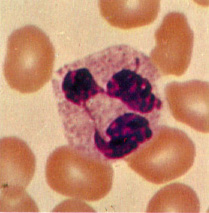 |
Neutrophils have nuclei with
several lobes and fine purple granules in their cytoplasm. Their are
termed neutrophil, because their
granules are not very amenable to staining with either acidic or
basic dyes. They are the most numerous of the leukocytes, making up
50-70%. |
|
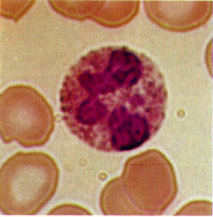 |
Eosinophils feature large
granules that can be stained bright red with an acidic dye -
e.g. eosin. They most often have bi-lobed nuclei. They make up
about 1-4% of the leukocytes |
|
|
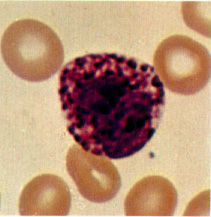 |
Basophils have multi-lobulated nuclei and large granules which stain blue with
basic dyes. They occur quite seldomly (less than .1%). |
|
|
Agranulocytes |
|
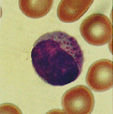 |
Lymphocytes can be large or
small. They are spherical and have a very large nucleus taking up
most of the cytoplasm. The cytoplasm has no granules. Lymphocytes
represent 20-40% of all leukocytes. |
|
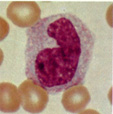 |
Monocytes are large cells.
They have large indented nuclei, often kidney-shaped and very fine
cytoplasmic granules. They make up 2-8% of the leukocytes. |
|
|
Deviations of different white cell counts from the normal
values often indicate a diseased state.
Neutrophilia (high neutrophil count)
often signals localized infections such as appendicitis;
eosinophilia (high
eosinophil count) may indicate allergic conditions or invasion by parasites such as
Trichinella; lymphocytosis (high lymphocyte count) may be seen in some viral
infections; neutropenia (low neutrophil count) occurs in typhoid fever, measles
or infectious hepatitis, and eosinopenia (low eosinophil count) may be produced
by an elevated secretion of corticosteroids (in states of stress). |
|
To practice with the
differential white cell count, click here |